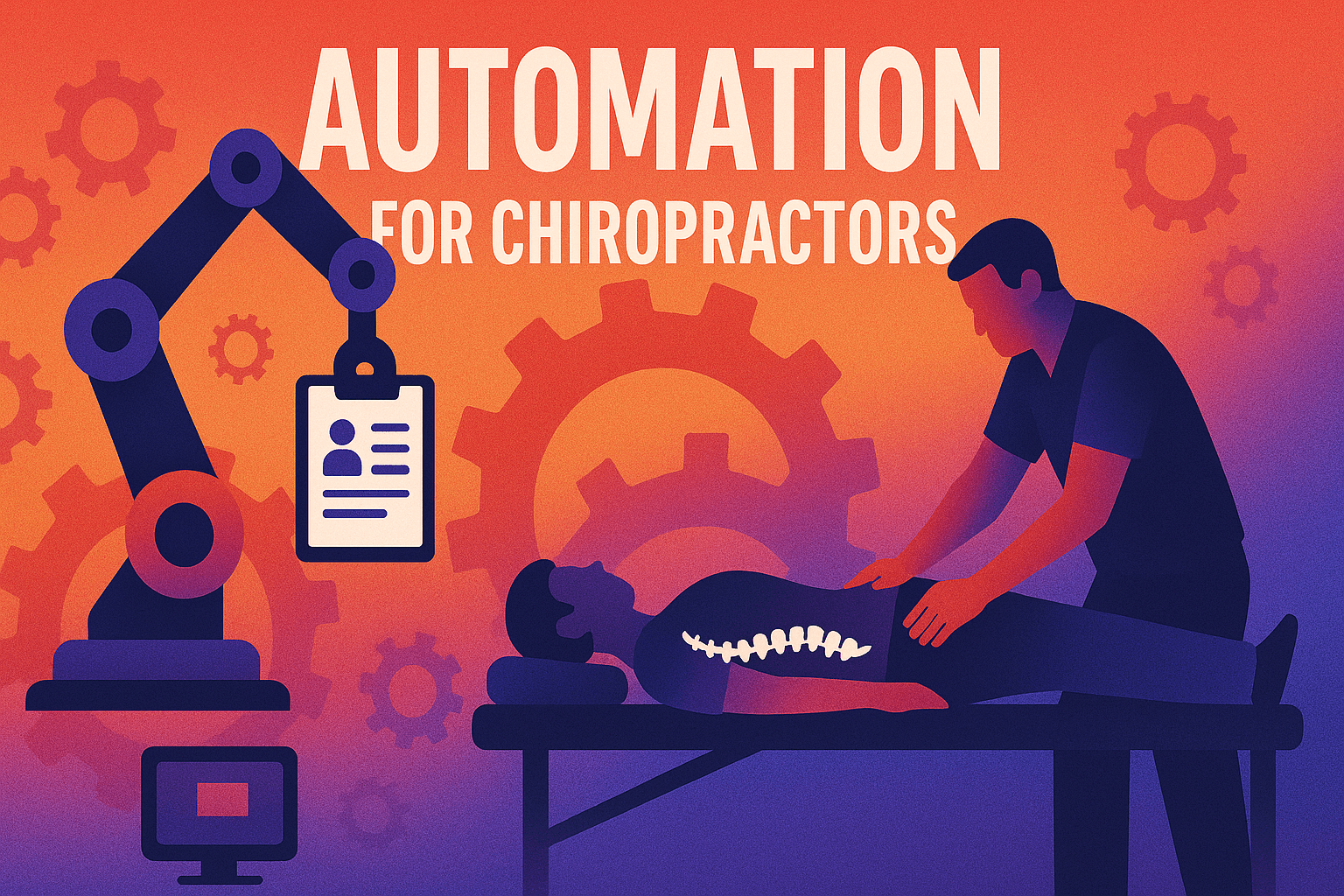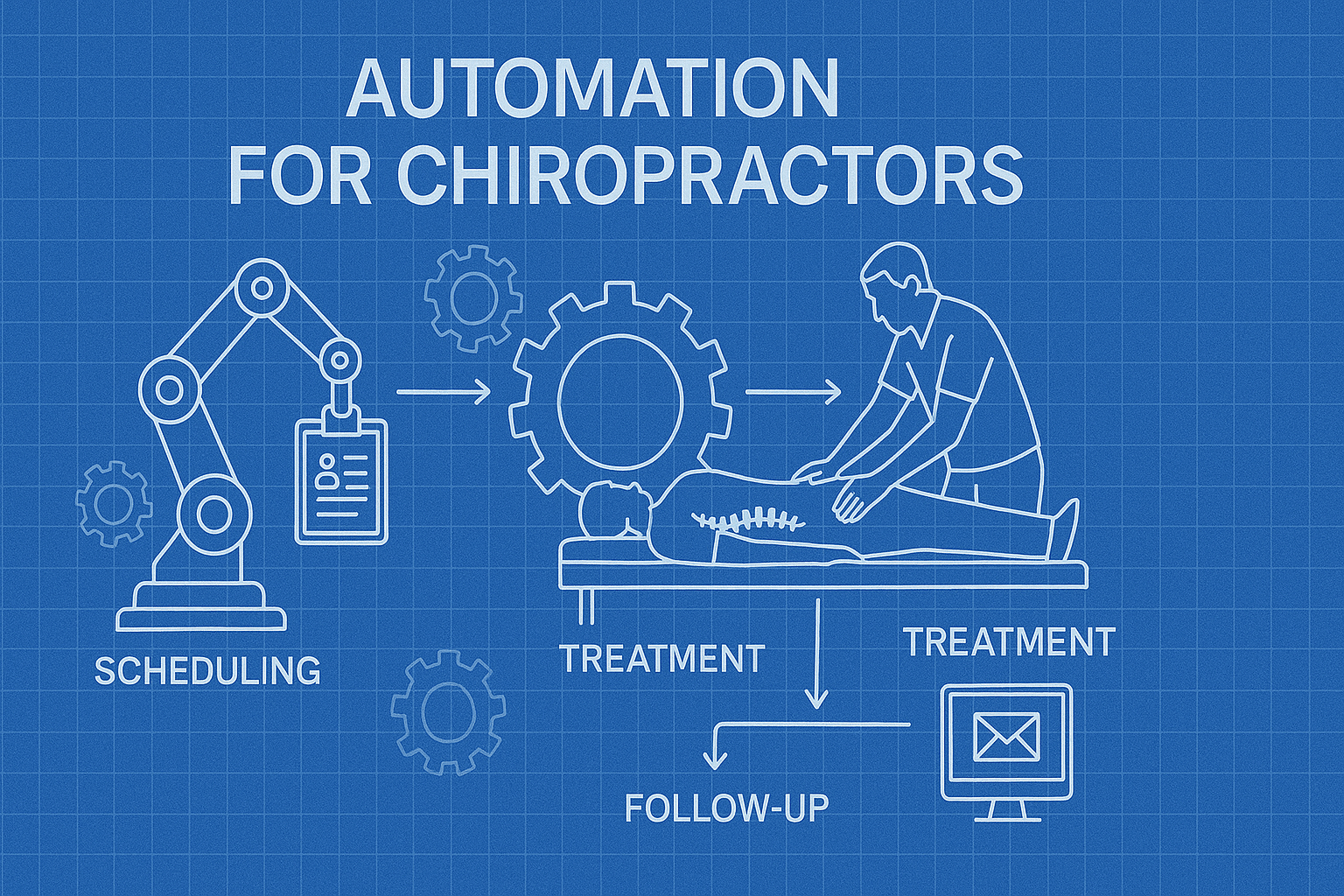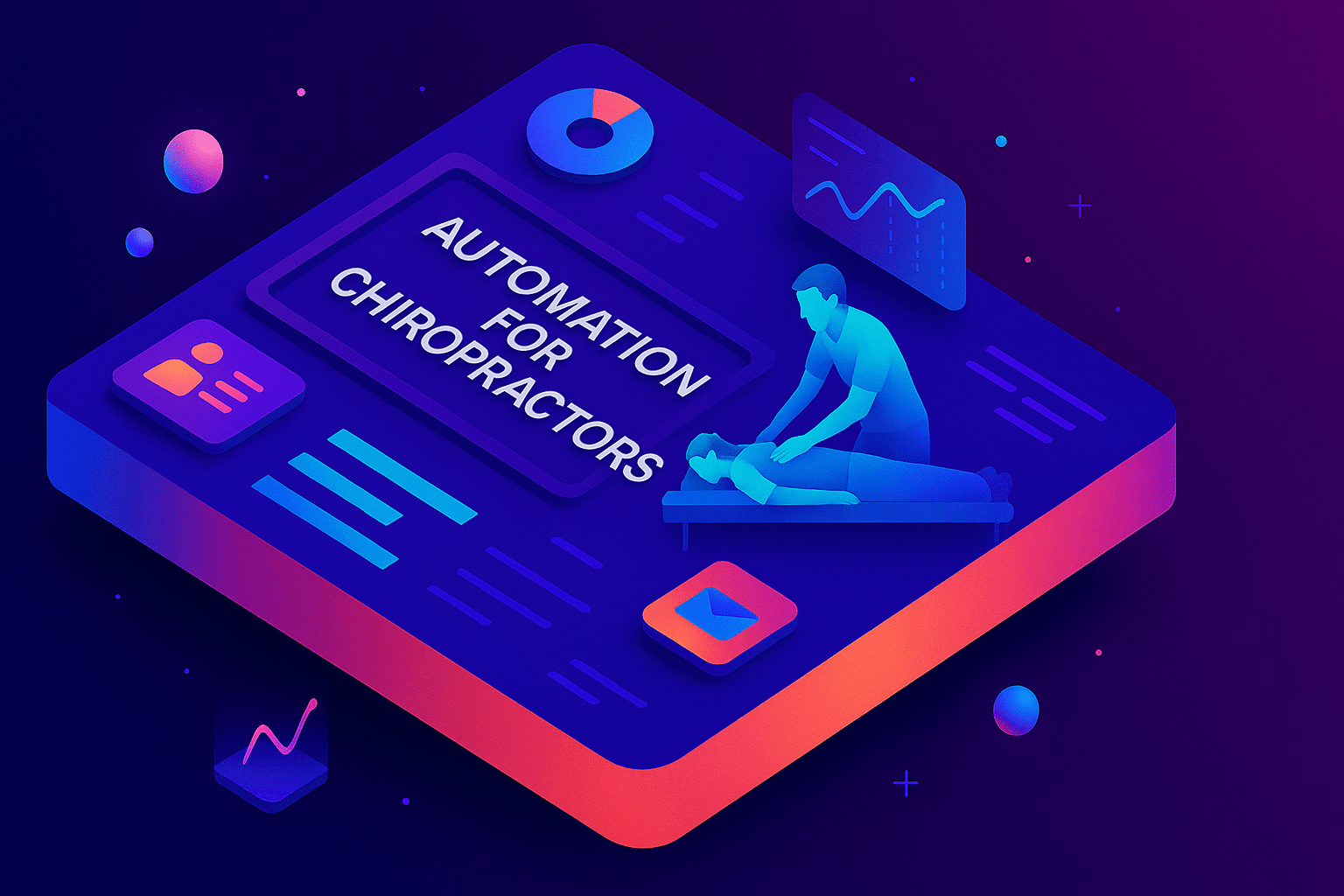Chiropractors Guide to Automation: From Basics to Best-in-Class
by Design Delulu Editorial · September 30, 2025

Smart, fast, and measurable automation systems that help chiropractors reduce administrative burden, improve patient experience, and scale their practice efficiently.
Why Automation Matters for Chiropractors
Running a successful chiropractic practice means balancing patient care with the overwhelming demands of scheduling, billing, patient communication, and follow-ups. The average chiropractor spends 15-20 hours per week on administrative tasks that could be automated, time that should be invested in patient outcomes and practice growth. Automation isn't about replacing the human touch that defines great chiropractic care—it's about eliminating repetitive tasks so you can focus on what matters: healing patients and building relationships.
The chiropractors who implement intelligent automation systems see immediate improvements across multiple metrics: 40% reduction in no-shows through automated reminders, 3x faster patient intake with digital forms, and 60% less time spent on insurance verification. More importantly, automation creates a consistent patient experience from first contact through treatment completion, building trust and increasing retention rates. When your systems work seamlessly in the background, patients notice—and they come back.

The Complete Automation Framework for Chiropractic Practices
Successful automation for chiropractors isn't about implementing every tool available—it's about strategically automating the right processes to maximize impact. Our framework focuses on four critical areas: patient acquisition, appointment management, treatment documentation, and patient retention. Each area presents specific opportunities to reduce manual work while improving patient outcomes and practice efficiency.
Key Benefits of Automation for Chiropractors
- Intelligent Appointment Management: Automated scheduling with real-time availability, smart reminders via SMS and email, and self-service rescheduling reduce no-shows by up to 45% while freeing your front desk staff to focus on in-person patient care.
- Streamlined Patient Intake: Digital forms with conditional logic, automatic insurance verification, and electronic consent collection cut intake time from 20 minutes to under 5 minutes, improving first-visit experience and operational efficiency.
- Automated Patient Communication: Triggered email and SMS campaigns for appointment reminders, treatment plan follow-ups, wellness tips, and re-engagement sequences keep patients informed and increase lifetime value by 35%.
- Billing and Payment Automation: Automated insurance claims submission, payment processing, and payment plan management reduce billing errors by 80% and accelerate cash flow with faster reimbursement cycles.
- Marketing Automation: Lead nurturing sequences, review request campaigns, referral program automation, and patient reactivation workflows generate consistent new patient flow without manual effort.
- Treatment Documentation: SOAP note templates, automated treatment plan generation, progress tracking dashboards, and outcomes measurement tools ensure compliance while reducing documentation time by 50%.
How Chiropractic Practice Automation Works
- Discovery & Assessment: We audit your current workflows, identify bottlenecks consuming staff time, map your patient journey from awareness to retention, and define clear success metrics aligned with your practice goals. This phase includes interviews with your team, analysis of existing systems, and documentation of pain points that automation can solve.
- Strategy & Blueprint: We design a custom automation architecture that integrates with your existing practice management software, create detailed process maps for each automated workflow, establish data governance protocols for HIPAA compliance, and build a phased implementation roadmap that minimizes disruption to daily operations.
- Implementation & Integration: We configure automation tools to match your specific workflows, integrate systems for seamless data flow between platforms, set up tracking and analytics to measure impact, conduct thorough QA testing with real-world scenarios, and train your team on new processes with comprehensive documentation and support materials.
- Launch & Optimization: We deploy automation systems in phases to ensure smooth adoption, monitor performance metrics against baseline benchmarks, gather feedback from staff and patients, identify optimization opportunities, and continuously refine workflows based on data insights to maximize ROI and patient satisfaction.

What You'll Receive: Complete Automation Deliverables
- Automated Workflow Documentation: Detailed process maps for every automated workflow, including patient intake, appointment management, billing cycles, and marketing campaigns, with clear decision trees and trigger logic.
- System Integration Setup: Fully configured connections between your practice management software, payment processors, email marketing platforms, SMS services, and analytics tools, ensuring seamless data flow and eliminating manual data entry.
- Custom Dashboard & Reporting: Real-time analytics dashboard tracking key practice metrics including appointment volume, patient acquisition cost, retention rates, revenue per patient, and operational efficiency indicators.
- Patient Communication Templates: Pre-built email and SMS templates for appointment reminders, new patient welcome sequences, treatment plan education, wellness tips, reactivation campaigns, and review requests—all customizable to your practice voice.
- Team Training & Documentation: Comprehensive training sessions for your staff, video tutorials for common tasks, written standard operating procedures, and ongoing support documentation to ensure successful adoption.
- Compliance Framework: HIPAA-compliant automation protocols, data security guidelines, consent management systems, and audit trails to protect patient information and maintain regulatory compliance.
Best Practices for Chiropractic Practice Automation
- Start with High-Impact, Low-Complexity Workflows: Begin by automating appointment reminders and patient intake forms—these deliver immediate ROI and build momentum for more complex automation projects.
- Maintain the Personal Touch: Use automation to handle repetitive tasks, but preserve human interaction at critical moments like initial consultations, treatment planning discussions, and check-out conversations that build relationships.
- Measure Everything: Track baseline metrics before automation, monitor key performance indicators weekly, and calculate ROI monthly to justify continued investment and identify areas for improvement.
- Integrate Don't Duplicate: Connect your automation tools to existing systems rather than creating data silos—integration ensures accuracy, reduces manual work, and provides a complete view of practice performance.
- Test Before Full Deployment: Run pilot programs with a small group of patients, gather feedback from staff on usability, refine workflows based on real-world results, then scale to your entire practice.
- Prioritize Patient Experience: Every automation should improve the patient journey—if a workflow creates friction or confusion, redesign it. The best automation is invisible to patients while making their experience effortless.
- Plan for Continuous Improvement: Schedule quarterly automation audits, review performance data regularly, gather ongoing feedback from your team, and stay updated on new tools and capabilities in the healthcare automation space.
Industry-Specific Automation Strategies for Chiropractors
- New Patient Acquisition Automation: Implement automated lead capture on your website with instant response sequences, create nurture campaigns that educate prospects about chiropractic care benefits, set up retargeting workflows for abandoned booking attempts, and automate referral requests from satisfied patients—chiropractors using these systems see 3x more consultation bookings.
- Treatment Plan Compliance Automation: Design automated check-ins between appointments to monitor patient progress, create triggered reminders for prescribed exercises and self-care protocols, implement milestone celebration messages to motivate continued treatment, and set up re-engagement sequences for patients who fall off their care plans—practices using compliance automation report 50% better treatment completion rates.
- Insurance Verification & Billing: Automate eligibility verification before appointments to prevent surprises, implement real-time benefit checks during scheduling, create automated claims submission workflows that reduce rejection rates, and set up payment plan automation for patients with high deductibles—reducing billing cycle times from 45 days to under 20 days.
- Wellness Program Automation: Build automated wellness content delivery based on patient conditions and treatment phase, create seasonal health campaigns that keep your practice top-of-mind, implement birthday and care anniversary messages that strengthen relationships, and automate class and workshop registration—turning one-time patients into lifetime wellness advocates.
- Review & Reputation Management: Trigger review requests automatically after successful treatment milestones, create feedback loops that identify dissatisfied patients before they leave negative reviews, automate social proof collection for marketing materials, and implement referral program automation—practices with systematic reputation management average 4.7+ star ratings and 30% more Google visibility.
- Staff Productivity Optimization: Automate routine reporting so staff can focus on patient care, implement task assignment workflows that distribute work evenly, create automated training and onboarding sequences for new team members, and set up performance dashboards that track individual and practice-wide metrics—reducing administrative overhead by up to 40%.
Common Automation Use Cases for Chiropractic Practices
Appointment Scheduling & Management
Replace phone tag with 24/7 online booking that shows real-time availability, allows patients to choose their preferred appointment times, and automatically updates your calendar. Implement smart reminder sequences via SMS and email at 48 hours, 24 hours, and 4 hours before appointments, with one-click confirmation and self-service rescheduling. Add waitlist automation that fills cancellations immediately by alerting patients who requested earlier times. The result: 40-50% reduction in no-shows, 10+ hours saved weekly on scheduling tasks, and higher patient satisfaction scores.
New Patient Onboarding
Create a seamless first impression with automated welcome sequences that begin the moment someone books a consultation. Send pre-appointment emails with office location, parking information, what to expect, and digital intake forms that patients complete before arrival. Automate insurance verification, medical history collection, and consent form signing. After the first visit, trigger an educational email series about chiropractic care, treatment expectations, and success stories. This automation reduces first-visit intake time from 20+ minutes to under 5 minutes while improving patient education and setting clear expectations.
Treatment Plan Communication
After creating a treatment plan, automatically send a detailed summary via email with visit frequency, expected timeline, cost breakdown, and insurance coverage information. Set up reminder sequences for scheduled treatments, automated check-ins between visits to monitor progress, and educational content that reinforces the treatment plan rationale. For patients on long-term care plans, create milestone messages celebrating progress and motivating continued compliance. Practices using treatment plan automation report 35% higher plan completion rates and better patient outcomes.
Patient Reactivation Campaigns
Automatically identify patients who haven't scheduled appointments in 60, 90, or 180 days and trigger personalized re-engagement sequences. Start with gentle check-in messages asking about their wellbeing, progress to reminder messages about the importance of maintenance care, and include special offers or new service announcements to incentivize return visits. Segment campaigns based on the reason for initial treatment (acute pain, chronic condition, wellness care) to make messaging more relevant. Well-executed reactivation automation brings 15-25% of dormant patients back to active care.

Measuring Automation Success: Key Performance Indicators
The most successful chiropractic automation implementations focus on metrics that directly impact practice growth and patient outcomes. Track these essential KPIs monthly to ensure your automation investment delivers measurable returns:
Patient Acquisition Metrics
- New Patient Conversion Rate: Percentage of website visitors or inquiry calls that book a consultation—automation typically improves this by 25-40% through faster response times and streamlined booking.
- Cost Per New Patient: Total marketing spend divided by new patients acquired—automation reduces this by 30-50% through improved lead nurturing and reduced manual follow-up time.
- Lead Response Time: Time from initial inquiry to first practice contact—automation enables instant response, dramatically improving conversion compared to manual follow-up delays.
Operational Efficiency Metrics
- No-Show Rate: Percentage of scheduled appointments where patients don't arrive—automation with multi-channel reminders typically reduces no-shows from 20-25% down to 5-10%.
- Administrative Hours Per Week: Staff time spent on scheduling, billing, patient communication—automation commonly saves 15-25 hours weekly in a mid-sized practice.
- Patient Intake Time: Minutes from arrival to treatment room—automation reduces this from 15-20 minutes to under 5 minutes through pre-appointment form completion.
Revenue & Retention Metrics
- Treatment Plan Completion Rate: Percentage of patients who complete recommended care plans—automation improves this from 40-50% to 70-85% through systematic follow-up and education.
- Patient Lifetime Value: Total revenue per patient over their relationship with your practice—automation increases LTV by 35-50% through better retention and treatment plan compliance.
- Days in Accounts Receivable: Average time from service delivery to payment receipt—automation accelerates this from 45+ days to 20-25 days through streamlined billing and claims processing.
- Patient Retention Rate: Percentage of patients who return for continued care—automation with systematic follow-up improves retention by 25-40%.
Choosing the Right Automation Tools for Your Practice
The chiropractic automation landscape includes dozens of tools, but the best approach focuses on integrated platforms that work together seamlessly. Your practice management system should serve as the central hub, with specialized automation tools connecting to it for marketing, communication, and analytics. Prioritize tools with HIPAA compliance, strong integration capabilities, excellent support, and pricing that scales with your practice size. Most successful implementations include a practice management system (like ChiroTouch or Platinum System), email marketing platform (like Mailchimp or ActiveCampaign), SMS automation tool (like SimpleTexting), and scheduling software (like Acuity or embedded in your PM system).
Implementation Timeline & Investment
Most chiropractic practices can implement comprehensive automation in 4-8 weeks with the right partner. Week 1 focuses on discovery and workflow mapping, weeks 2-3 on system configuration and integration, weeks 4-5 on testing and refinement, and weeks 6-8 on team training and gradual rollout. Investment typically ranges from $5,000-$15,000 for initial setup depending on practice size and complexity, with ongoing costs of $300-$800 monthly for software subscriptions. The ROI usually becomes positive within 3-4 months as efficiency gains and improved patient retention compound, with annual returns often exceeding 300-500% of the initial investment.
Frequently Asked Questions
Let’s level up your Chiropractors business
Need services that actually move the needle for Chiropractors? See our approach, pricing, and timelines—then book a quick call.
Additional Resources
- Analytics & Measurement for Chiropractors
Automation without measurement is guesswork. We implement GA4, server-side tracking, attribution modeling, and custom dashboards that show exactly which marketing investments drive patient revenue—not just vanity metrics.
- SEO Services for Chiropractors
Automation drives better results when combined with strong local SEO. Rank higher for 'chiropractor near me' searches, optimize your Google Business Profile, and dominate local search results to fill your automation funnel with qualified leads.
- Content Marketing for Chiropractors
Feed your automated nurture sequences with compelling content. We create condition-specific guides, video content, blog posts, and patient education materials that establish authority and convert prospects into patients.
Related Reading

Discover how automation for electricians streamlines scheduling, invoicing, lead tracking, and customer follow-ups to boost revenue and efficiency. Get started today.

Discover how automation streamlines furniture & home decor operations with GA4 tracking, attribution modeling, and data-driven dashboards. Get your 90-day implementation roadmap.
